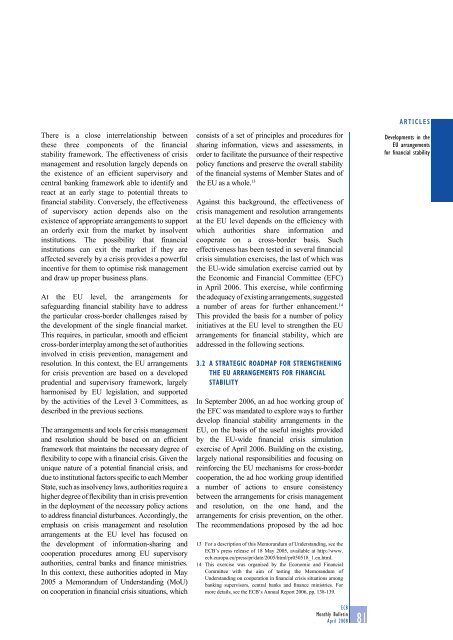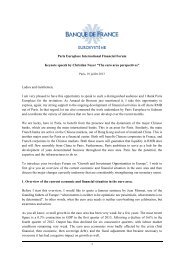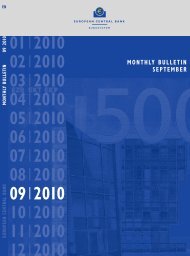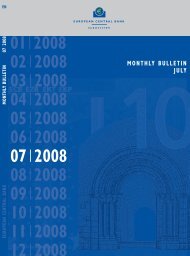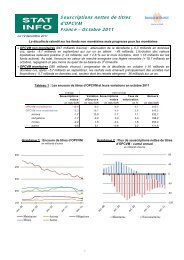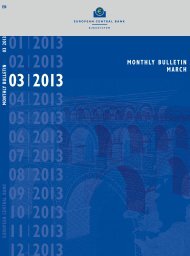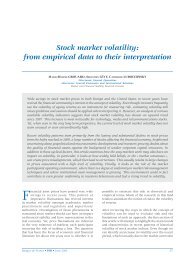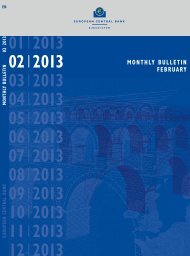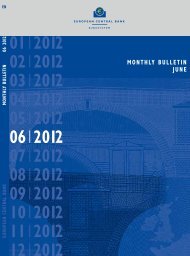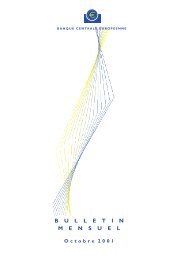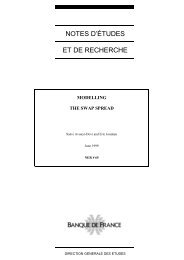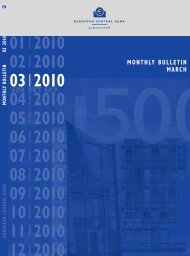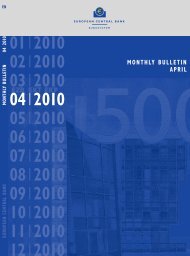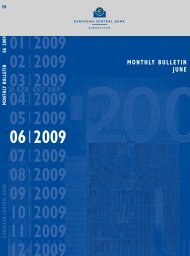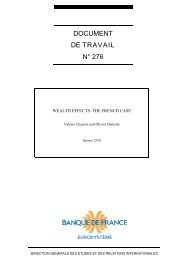Monthly Bulletin April 2008 - European Central Bank - Europa
Monthly Bulletin April 2008 - European Central Bank - Europa
Monthly Bulletin April 2008 - European Central Bank - Europa
Create successful ePaper yourself
Turn your PDF publications into a flip-book with our unique Google optimized e-Paper software.
There is a close interrelationship between<br />
these three components of the financial<br />
stability framework. The effectiveness of crisis<br />
management and resolution largely depends on<br />
the existence of an efficient supervisory and<br />
central banking framework able to identify and<br />
react at an early stage to potential threats to<br />
financial stability. Conversely, the effectiveness<br />
of supervisory action depends also on the<br />
existence of appropriate arrangements to support<br />
an orderly exit from the market by insolvent<br />
institutions. The possibility that financial<br />
institutions can exit the market if they are<br />
affected severely by a crisis provides a powerful<br />
incentive for them to optimise risk management<br />
and draw up proper business plans.<br />
At the EU level, the arrangements for<br />
safeguarding financial stability have to address<br />
the particular cross-border challenges raised by<br />
the development of the single financial market.<br />
This requires, in particular, smooth and efficient<br />
cross-border interplay among the set of authorities<br />
involved in crisis prevention, management and<br />
resolution. In this context, the EU arrangements<br />
for crisis prevention are based on a developed<br />
prudential and supervisory framework, largely<br />
harmonised by EU legislation, and supported<br />
by the activities of the Level 3 Committees, as<br />
described in the previous sections.<br />
The arrangements and tools for crisis management<br />
and resolution should be based on an efficient<br />
framework that maintains the necessary degree of<br />
flexibility to cope with a financial crisis. Given the<br />
unique nature of a potential financial crisis, and<br />
due to institutional factors specific to each Member<br />
State, such as insolvency laws, authorities require a<br />
higher degree of flexibility than in crisis prevention<br />
in the deployment of the necessary policy actions<br />
to address financial disturbances. Accordingly, the<br />
emphasis on crisis management and resolution<br />
arrangements at the EU level has focused on<br />
the development of information-sharing and<br />
cooperation procedures among EU supervisory<br />
authorities, central banks and finance ministries.<br />
In this context, these authorities adopted in May<br />
2005 a Memorandum of Understanding (MoU)<br />
on cooperation in financial crisis situations, which<br />
consists of a set of principles and procedures for<br />
sharing information, views and assessments, in<br />
order to facilitate the pursuance of their respective<br />
policy functions and preserve the overall stability<br />
of the financial systems of Member States and of<br />
the EU as a whole. 13<br />
Against this background, the effectiveness of<br />
crisis management and resolution arrangements<br />
at the EU level depends on the efficiency with<br />
which authorities share information and<br />
cooperate on a cross-border basis. Such<br />
effectiveness has been tested in several financial<br />
crisis simulation exercises, the last of which was<br />
the EU-wide simulation exercise carried out by<br />
the Economic and Financial Committee (EFC)<br />
in <strong>April</strong> 2006. This exercise, while confirming<br />
the adequacy of existing arrangements, suggested<br />
a number of areas for further enhancement. 14<br />
This provided the basis for a number of policy<br />
initiatives at the EU level to strengthen the EU<br />
arrangements for financial stability, which are<br />
addressed in the following sections.<br />
3.2 A STRATEGIC ROADMAP FOR STRENGTHENING<br />
THE EU ARRANGEMENTS FOR FINANCIAL<br />
STABILITY<br />
In September 2006, an ad hoc working group of<br />
the EFC was mandated to explore ways to further<br />
develop financial stability arrangements in the<br />
EU, on the basis of the useful insights provided<br />
by the EU-wide financial crisis simulation<br />
exercise of <strong>April</strong> 2006. Building on the existing,<br />
largely national responsibilities and focusing on<br />
reinforcing the EU mechanisms for cross-border<br />
cooperation, the ad hoc working group identified<br />
a number of actions to ensure consistency<br />
between the arrangements for crisis management<br />
and resolution, on the one hand, and the<br />
arrangements for crisis prevention, on the other.<br />
The recommendations proposed by the ad hoc<br />
13 For a description of this Memorandum of Understanding, see the<br />
ECB’s press release of 18 May 2005, available at http://www.<br />
ecb.europa.eu/press/pr/date/2005/html/pr050518_1.en.html.<br />
14 This exercise was organised by the Economic and Financial<br />
Committee with the aim of testing the Memorandum of<br />
Understanding on cooperation in financial crisis situations among<br />
banking supervisors, central banks and finance ministries. For<br />
more details, see the ECB’s Annual Report 2006, pp. 138-139.<br />
ARTICLES<br />
Developments in the<br />
EU arrangements<br />
for financial stability<br />
ECB<br />
<strong>Monthly</strong> <strong>Bulletin</strong><br />
<strong>April</strong> <strong>2008</strong><br />
81


